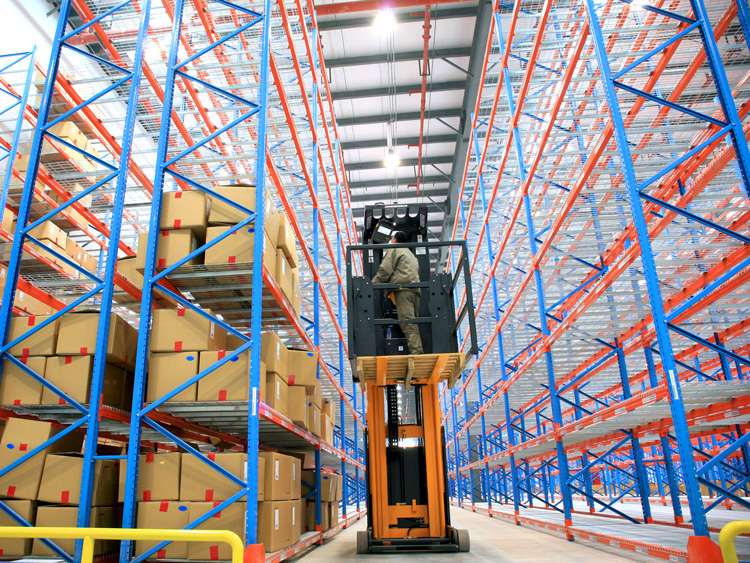The advantages of selective pallet racking
As a warehouse operator, you’re constantly balancing the needs of storage capacity, accessibility, and cost. Choosing the right storage system is one of the most critical decisions you’ll make, directly impacting your daily operations and profitability. Among the many available options, one system consistently stands out for its versatility and reliability: selective pallet racking.
This article explores the key advantages of selective pallet racking and explains why it remains the most popular and widely used warehouse storage solution worldwide.
What is Selective Pallet Racking?
Before diving into its benefits, let’s quickly define selective pallet racking. It’s a versatile storage system composed of an upright frame and horizontal beams that create multi-level storage. As the name suggests, it provides direct, selective access to each pallet load stored in the system without moving any other loads. This simple yet powerful design is the foundation of its many advantages.
The Key Advantages of Selective Pallet Racking
1. 100% Direct Accessibility and Instant Selection
The most significant advantage of selective racking is the unimpeded access it provides to every SKU (Stock Keeping Unit) in your inventory.
* How it works:
Each pallet is stored in its own bay, facing the warehouse aisle. This means forklift operators can immediately locate, retrieve, or store any specific pallet without having to move other pallets.
* Benefit:
This is ideal for high-turnover inventory or facilities with a large number of SKUs. It perfectly supports First-In, First-Out (FIFO) inventory management, which is crucial for perishable goods or products with expiration dates. This direct access can reduce labor time by up to 30% compared to more complex systems, dramatically speeding up order fulfillment.
2. Flexibility and Customizability
No two warehouses are exactly alike, and selective pallet racking is designed to meet your unique needs.
* Adjustable Components:
Horizontal beams can be easily moved and adjusted vertically on the upright frames. This allows you to adjust the shelf height to accommodate products of various sizes, from small boxes to tall, bulky items.
* Benefit:
Your storage system can evolve with your business. If your product mix changes seasonally or you begin stocking new items, you can reconfigure the racks without needing a completely new system. This adaptability future-proofs your investment and delivers excellent long-term value.
3. Excellent Space Utilization (Both Vertical and Horizontal)
Selective racking is designed to help you make the most of your existing space.
* Vertical Storage:
These systems can be built to considerable heights, often reaching 11 meters or more in facilities with ample clear height, effectively doubling or tripling your storage capacity without expanding the building’s footprint.
* Efficient Layout:
While it requires wider aisles than some high-density racking systems, the layout is highly efficient for frequent access. The simple design minimizes wasted space within the rack structure itself, maximizing the number of pallet positions.
4. Cost-Effectiveness and High Return on Investment
Selective pallet racking offers an ideal balance of performance and affordability.
* Lower Initial Cost:
It’s simple, standardized design and wide range of applications make it one of the most economical racking solutions to purchase and install.
* Reduced Operating Costs:
The increased efficiency of faster loading and unloading, combined with reduced training requirements for forklift operators (who can use standard equipment), helps lower the total cost of ownership.
* Durability:
Constructed of high-grade structural steel and typically finished with a corrosion-resistant powder coat, these systems offer decades of service with proper care, ensuring a strong return on investment.
5. Easy Installation, Maintenance, and Expansion
The modular nature of selective racking simplifies its entire lifecycle.
* Installation:
Compared to more integrated systems, selective racking is relatively quick and easy to install.
* Maintenance and Repair:
Individual components (such as beams or columns) can be easily replaced if damaged, minimizing downtime and repair costs. This is a significant advantage over welded systems.
* Expansion:
As your business grows, you can seamlessly add more racks to your existing configuration. This modular scalability allows for phased investment to align with your business growth.
6. Compatibility and Integration
Selective racking is the universal language of the warehouse. It works seamlessly with the following equipment:
* All Types of Forklifts:
Unlike some high-density systems that require specialized equipment, selective racking can be operated with any standard forklift or pallet truck.
* Warehouse Management Systems (WMS):
Its streamlined layout makes it easy to map within a WMS, enabling precise inventory tracking and management. When integrated with smart technologies like RFID, inventory accuracy can reach 99.8% or higher.
* Other Systems:
It can be easily combined with other storage solutions, such as mezzanines or shelving units, to create a hybrid storage environment tailored to specific needs.
Ideal Applications for Selective Pallet Racking
Given its advantages, selective racking is the preferred choice for the following applications:
* Distribution Centers with a high volume of diverse products.
* Manufacturing Facilities storing raw materials and finished goods.
* Retail Warehouses require strict first-in, first-out (FIFO) inventory rotation.
* Cold Storage facilities where fast access helps maintain stable temperatures.
* Any operation with a large number of SKUs that requires rapid, random order picking.
Conclusion:
While high-density systems (such as drive-in racking or automated solutions) have their place in specific, high-volume applications, selective pallet racking remains the gold standard for general warehouse storage. Its combination of full accessibility, flexibility, cost-effectiveness, and ease of use makes it an all-rounder.
By choosing a selective pallet racking system, you’re investing in a proven, scalable, and efficient backbone for your logistics operations—one that will support your business’s growth and adaptability for years to come.
Ready to optimize your warehouse space? Consult a professional storage solutions provider to design a selective racking layout that perfectly meets your unique requirements and achieves new levels of efficiency.
